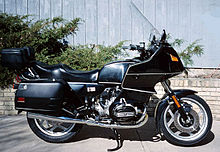
Summary
The BMW 247 engine is an air-cooled flat-twin motorcycle engine with two valves per cylinder, also known as the "airhead" boxer. It was used by BMW in its motorcycles from 1969 to 1995.


The /5 variant was introduced in 1969, /6 in 1974 and the /7 in 1977. Before 1981 the ignition was points ignition. From 1981, introduced in the R80G/S it used electronic ignition, Nikasil cylinders, and a lighter flywheel.[1]
A number of different models were on the market:
- CS: the Classic Sport, with a 1,000 cc (61 cubic inches) engine.
- GS: Gelände/Straße - winner of a number of the Dakar rallies.
- RS: Renn (Racing) Sport
- RT: Road Touring
- S: with the R90S
- ST: [Straße]. An 800 cc (49 cubic inches) road-styled G/S.
Subsequent to the type 247 motor, BMW also built other air-cooled flat twin engines known as the Typ 248/1 used for the R45, the R65 and the R65LS BMW motorcycles. Before that they built side-valve and OHV engines commencing with the R32 of 1923. After the type 247, BMW substantially changed the engine design to include partial oil cooling and four valves per cylinder, a design which was to become known as the "oilhead".
References edit


